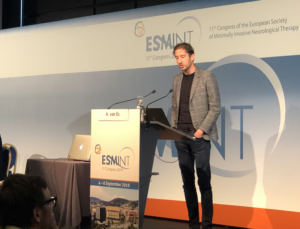The recent European Society of Minimally Invasive Neurological Therapy (ESMINT; 4–6 September, Nice, France) meeting saw Adriaan C G M van Es of Erasmus Medical Center in Rotterdam, the Netherlands, present an update on the MR CLEAN II trials underway in the country. While MR CLEAN LATE and MR CLEAN NO IV are progressing well in terms of patient inclusions, he said MR CLEAN MED is lagging, and for this reason, the trial will expand into France.

Further updates he alluded to were in regards to the inclusion criteria used for MR CLEAN LATE, a multicentre randomised controlled trial (RCT) investigating endovascular therapy in the time window 6–24 hours after symptoms onset. van Es said: “If you look closely at the populations included in DAWN and DEFUSE 3, you can see that the infarct core was very small: 18ml and 25ml for DAWN and DEFUSE 3, respectively.” Now, those with a small infarct core (<25ml) on CT perfusion, as well as an ischaemic tissue-to-core ratio of ≥1.8 and a National Institutes of Stroke Scale (NIHSS) score of over 10 are being excluded from the trial.
Generally speaking, van Es acknowledged the “liberal” inclusion and exclusion criteria for MR CLEAN LATE, given that even collateral grade 1 is sufficient to enter the study. He said that the investigators will include a maximum of 100 patients with poor collateral flow. In terms of technique, he added that any device can be used, employing a stentriever, aspiration or combined technique. Pointing to the progression of the trial, van Es proposed that the inclusion rate is “picking up”; since the first patient was enrolled in February of 2018, there have been 146 inclusions (as of August 2019).
The second trial he discussed was MR CLEAN MEDICINE: a multicentre RCT of endovascular treatment examining the effect of periprocedural medication—heparin, antiplatelet agents, both or either. While the study was previously a 2×3 factorial design, with the intervention being administration of aspirin (300mg loading dose) or no aspirin, in combination with unfractionated heparin (low dose, intermediate dose or no dose), van Es said, following the interim safety assessments, that there has been an unanimous decision to stop recruitment for the intermediate dose of heparin arm.
According to van Es, the safety and monitoring board for the MR CLEAN II trials is led by Peter Rothwell from the University of Oxford, Oxford, UK. An interim analysis is carried out after each five symptomatic ICH’s and/or after 10 deaths. It was after the fourth safety analysis when the decision was made to terminate the intermediate dose, meaning the trial’s design was adapted to a 2×2 factorial design.
Explaining the rationale behind this pharmacological intervention, van Es said: “As we all know, successful recanalisation does not always lead to restored tissue perfusion. However, this incomplete microvascular reperfusion is reversible, and can potentially be influenced by pharmacological therapy.” He added that microemboli can be derived from the proximal thrombus—locally formed by activated coagulation or by endothelial damage caused during endovascular therapy.
Further, another process that contributes to incomplete microvascular reperfusion, van Es said, is the formation of cellular plugs that block capillaries. “We call them neutrophil extracellular traps [NETS], and they consist of thrombocytes, erythrocytes, leucocytes and fibrin. Specifically, these NETS do not respond to rt-PA.” He put forward that these NETS can be targeted with heparin. While the risk for symptomatic ICH is approximately 2%, van Es noted that there is no RCT data on the effect of heparin during EVT.
Although recognising that the team is behind schedule in relation to recruitment, van Es said: “We are very happy that we can expand the study into France, and that we can start [recruiting] in six new centres in May; in Nancy, Nantes, Bordeaux, Montpellier and two in Paris.”
Last but not least, van Es alluded to the MR CLEAN NO IV trial, which looks into whether skipping IV thrombolysis before endovascular therapy leads to a 10% absolute increase in good outcome, in particular, by avoiding intracranial haemorrhage. “To summarise the trial, it compared direct intra-arterial thrombectomy with a combined approach of IV thrombolysis (rt-PA 0.9mg/kg) plus intra-arterial thrombectomy,” he told delegates at ESMINT.
The team’s aim is to include 540 patients using a very “pragmatic” inclusion and exclusion criteria. MR CLEAN NO IV uses deferred consent, meaning that patients can be randomised first, and asked for consent up to 90 days following randomisation.
Speaking on what motivated this study, van Es said that “quite a few” of observational studies are suffering from confounding variables—considering that the patients not receiving IV thrombolysis are likely to have contra-indications, such as an elevated INR, recent surgery or a late presentation.
According to van Es, this led the team in the Netherlands to conduct their own systematic review on the topic. They found 24 studies, with one post hoc analysis from an RCT, four prospective cohort studies and 19 retrospective cohort studies. “When these data are combined with unadjusted odds ratios, the data seem in favour for the group receiving IV thrombolysis and endovascular therapy. However,” he added, “if you look at the odds ratios that have been adjusted for confounders, there is a small favour for IV thrombolysis and endovascular therapy—which is not significant anymore.” Moreover, van Es told delegates that if you look at studies including only patients without contra-indications for IV thrombolysis, the data favour endovascular therapy alone, but again, this finding is also not statistically significant. “So simply, we can conclude that we are still not sure what to do,” surmised van Es.
With the first patient enrolled into MR CLEAN NO IV on 24 January 2018, 242 further patients have entered into the trial as of August 2019. van Es confirmed: “This trial is moving quite well, we have more inclusions that what we projected at this point, so we are very happy.”













